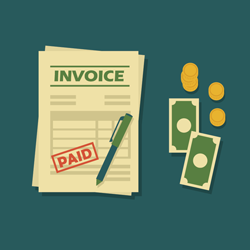
Exposing the Myths: SBA vs. Conventional Lending for Acquisitions
The Small Business Administration (SBA) offers lending programs that are often misunderstood as a cumbersome, last resort loan funding option.…
Admittedly, accounts receivable financing isn’t the first form of funding business owners will consider (if they even consider it all) when it comes to structuring long-term strategic changes such as acquisition, sale of a company or pursuing new channels of distribution. But used in part with long-term debt or equity financing, accounts receivable financing can help business owners free up capital to acquire another company, or enable target companies to take some money off the table, thereby lowering the acquisition cost.
Accounts receivable financing, otherwise known as factoring is one of the oldest forms of commercial finance. It has been a viable funding source for a long time. Unfortunately, certain players in the category (i.e., less reputable firms) have given the industry a black eye and perpetrated many myths—which are easily debunked.
Myth 1: A/R financing is only for troubled companies, which have no place left to turn for capital
There is a certain stigma that goes along with factoring. Many people believe that it is a business’s last resort before failure. Truth is, smart, savvy entrepreneurs commonly use the strategy to secure flexible and short-term solutions to working capital challenges. $120 billion in invoices paid by factors annually, exemplifies that this is not a fad—but truly a viable and respected form of financing.
Myth 2: A/R firms charge exorbitant rates
In fact, factors typically charge less than 2% all-in on the face value of an invoice to a credit-worthy customer who pays around 30 days. While this might seem high, ask yourself whether you would give a 2% discount to a customer who pays you inside 10 days. If the answer is yes, you should consider factoring—it is both cheaper and reverts more control over your cash flow to the business owner.
Myth 3: Turning receivables over to an A/R company means you’ve lost control over your company
The opposite is true. Selling your receivables can free you from the time-consuming tasks of collections so you can better focus your attention and energy on running and growing your business.
Myth 4: Factoring sends the wrong message to your customers
A good factor will work with you to craft a targeted communication plan that positions your partnership with the factor as a way to ensure access to capital, to grow your business and to further professionalize the accounts receivable management function.
To understand how A/R financing can work with other long-term financing options, it first helps to understand the difference. Accounts Receivable Financing, is a simple, and quick way to secure working capital for your business. You simply sell outstanding invoices to the A/R company and you’re given an advance on the receivables balance, thereby increasing your working capital without the wait. The lender typically requires a first position filing on the assets of the company or in some cases can orchestrate a carve-out of only certain collateral within the AR pool.
AR financing can work along-side mezzanine and other types of longer-term debt as long as the factor’s security interest is perfected. A common mistake for growing companies is to gravitate toward further equity infusions (a long term solution) to free up capital to pay suppliers and expand sell-through initiatives (a shorter term challenge). Increased equity may seem less expensive (and more enticing) but, the fact is, it’s a permanent change to the capital structure and dilutive to the original investors/owners.
After choosing the most appropriate financing instrument, it is equally as important to select the right funding partner. To feel comfortable with your decision, here are a few things to be aware of and important questions to ask yourself:
Flexibility: Are they willing to think outside the box and create a structure that really fits my business? Will they consider creating additional availability against inventory or work toward non-notification in certain instances?
Bridge: Will I be able to exit the contract when I no longer need alternative lending, even if the contract term is not officially up? Are the termination penalties egregious? Do they have bank relationships that will accelerate my path to bank financing?
Transparency: Is it clear what the fees are and how they apply? Ask them to run you through an example of what fees would apply on a typical invoice and to provide that in writing.
Growth: What determines the size of the capital facility? If my receivables grow, will they increase the credit limits real time? What kind of factoring volume can they handle?
Speed: Everybody says they fund quickly—but what are some objective measures? Is it not in the lender’s best interest to fund more slowly?
Access: Once the sale is made, who is my go-to person? How can I ensure that I will be a priority for that manager?
Technology: Ask to see technology. How user-friendly is it? Is it real time? Does it readily help me manage my working capital position?
Reputation: Ask for references. What is the incidence of fraud in the portfolio? How long do customers stay with them? Why do customers leave?
Capital: Who finances the organization? This is an unregulated industry so public disclosure is not required. Try to get a sense as to whether they are well capitalized and their staying power in the industry.
Many companies get hung up on the cost of AR financing. Yes, it is more costly than traditional bank financing, but the opportunity cost of turning down new business because it cannot be financed is much greater. Consider the following example:
A $5 million distributor of electronics accessories has been selling into a few medium-sized retailers for years and revenues have been stagnant. Gross profit margins have averaged about 20%. The company lands a choice PO for $5 million from one of the big-box retailers for a new product offering. Suppliers are willing to provide terms and there is enough capital to fund most of the first order. Problem is, it will starve the rest of the business and, given payment terms dictated by the big-box retailer of 60 days, stretch the company’s ability to continue production of any further orders.
On the other hand, at 2% per 30 days factoring would take the company’s margins on the new business down to 16%. And with revenues of $10 million (instead of $5) and assuming no increase in fixed costs, gross profit increases to $1.6 million. As an added bonus, access to a new distribution channel portends even greater growth for the company.
Given all the advantages of Accounts Receivable financing, it’s time to not only give it the respect it deserves, but to recognize this valuable short-term working capital solution for its many long-term benefits.
